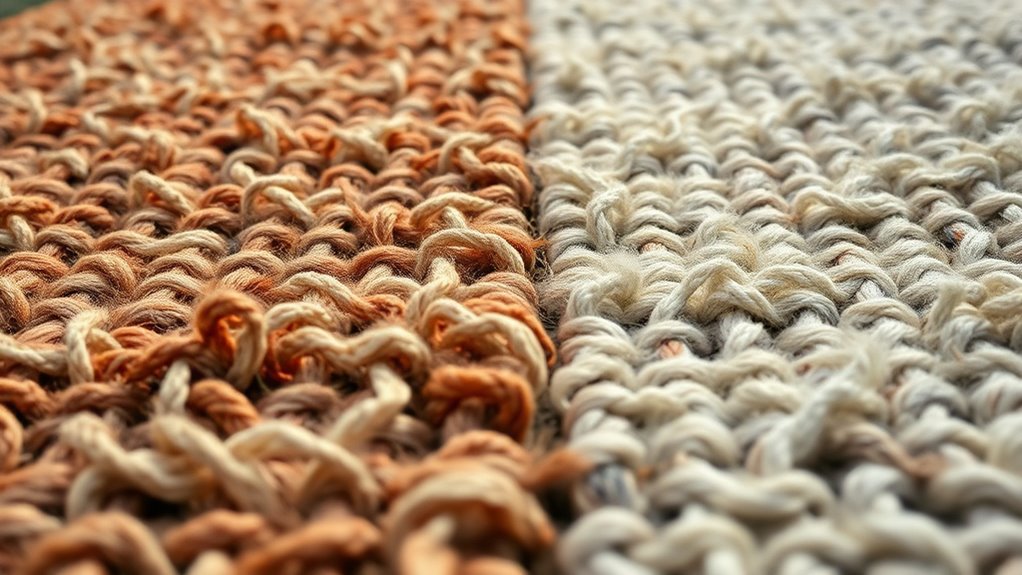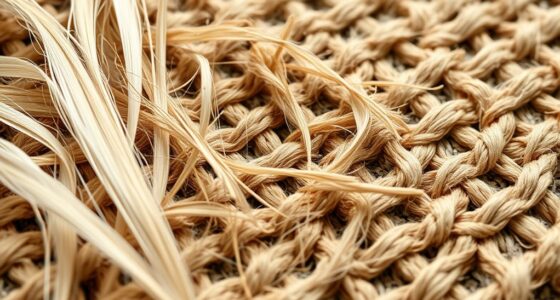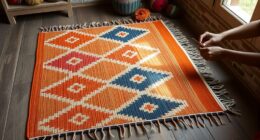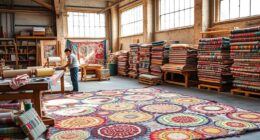Choosing a hand-knotted rug usually means a lower carbon footprint since it relies on natural fibers, manual craft, and eco-friendly dyes, burning less energy and producing minimal emissions. Machine-made rugs often involve synthetic materials, chemical dyes, and energy-intensive processes, increasing pollution and greenhouse gases. With sustainable sourcing and traditional techniques, handmade rugs support environmental health and longevity. To discover how these factors stack up across the entire lifecycle, you can explore the details further.
Key Takeaways
- Hand-knotted rugs have a lower energy footprint but require extensive manual labor, while machine-made rugs consume more energy due to automation.
- Natural fibers and dyes in handmade rugs result in a smaller environmental impact compared to synthetic materials and chemicals used in machine production.
- Manufacturing hand-knotted rugs involves minimal machinery and emissions, whereas machine-made rugs often rely on energy-intensive factories.
- Handmade rugs are more biodegradable and easier to recycle, reducing long-term waste compared to synthetic, non-recyclable machine-made options.
- Supporting artisanal craftsmanship promotes sustainable practices and fair labor, enhancing social and environmental benefits over mass-produced rugs.
The Production Process of Hand-Knotted Rugs
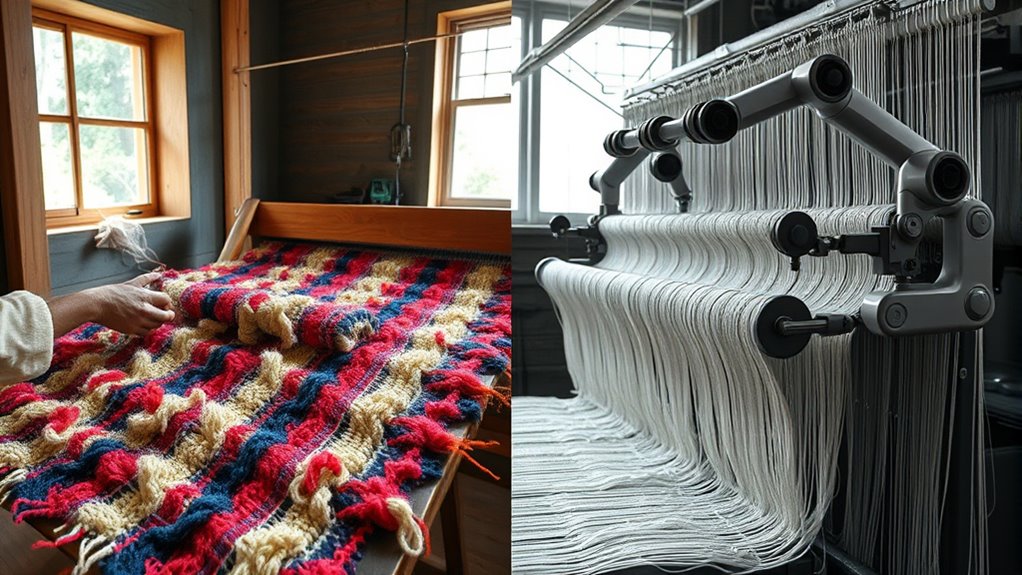
The production process of hand-knotted rugs involves a meticulous and labor-intensive method that considerably impacts their carbon footprint. You’re likely aware that skilled artisans use traditional hand knotting techniques, carefully tying each knot by hand. These methods require hours, sometimes months, to complete a single rug, reflecting their cultural significance and craftsmanship. Every knot contributes to the rug’s unique design and durability, making each piece a work of art. This process relies heavily on manual labor and natural materials, which reduces reliance on machinery and minimizes energy consumption. However, the extensive time and effort involved increase the overall environmental impact. While hand-knotting preserves cultural heritage, it’s essential to recognize its carbon footprint, especially when compared to machine-made alternatives. Additionally, the production techniques employed in hand-knotting influence both the environmental footprint and the quality of the finished product. Understanding the environmental impact of these methods can help consumers make more sustainable choices when selecting artisan rugs.
The Manufacturing of Machine-Made Rugs
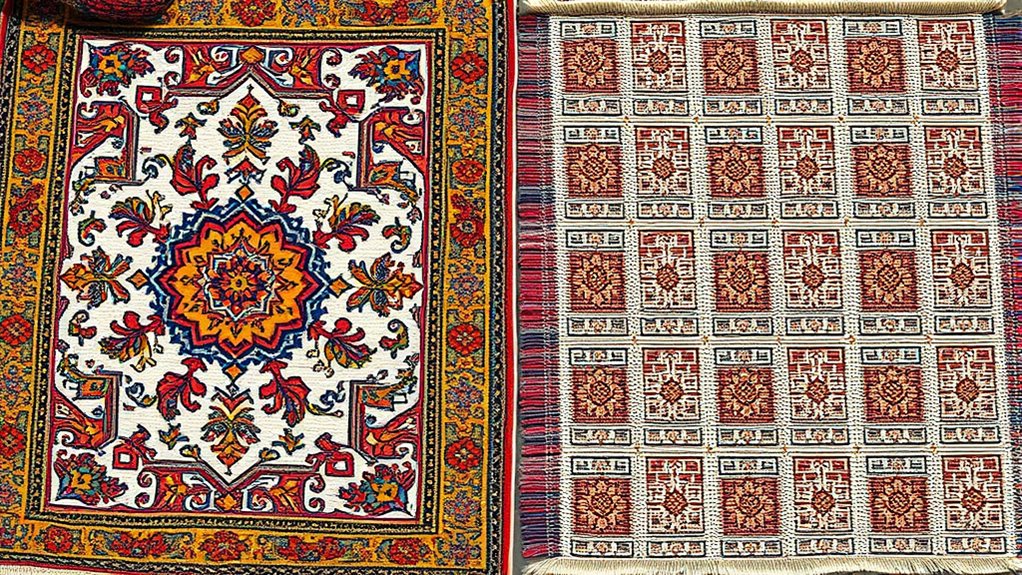
Machine-made rugs are produced using automated machinery that considerably speeds up the manufacturing process. You’ll find that synthetic fibers, such as polyester or polypropylene, are commonly used because they’re durable and cost-effective. These fibers are fed into machines that weave or tuft the rug pattern quickly and efficiently. Dye chemicals are applied to color the fibers, often through automated dyeing processes that reduce waste and ensure consistency. Because of this automation, production times are much shorter compared to hand-knotting. However, the reliance on synthetic fibers and chemical dyes can increase the environmental footprint, especially regarding resource use and waste. Overall, machine-made rug manufacturing emphasizes speed and uniformity, but it also involves significant chemical and synthetic material consumption. Additionally, the energy consumption associated with large-scale machinery contributes to a higher carbon footprint compared to traditional hand-knotting methods.
Material Sourcing and Environmental Impact
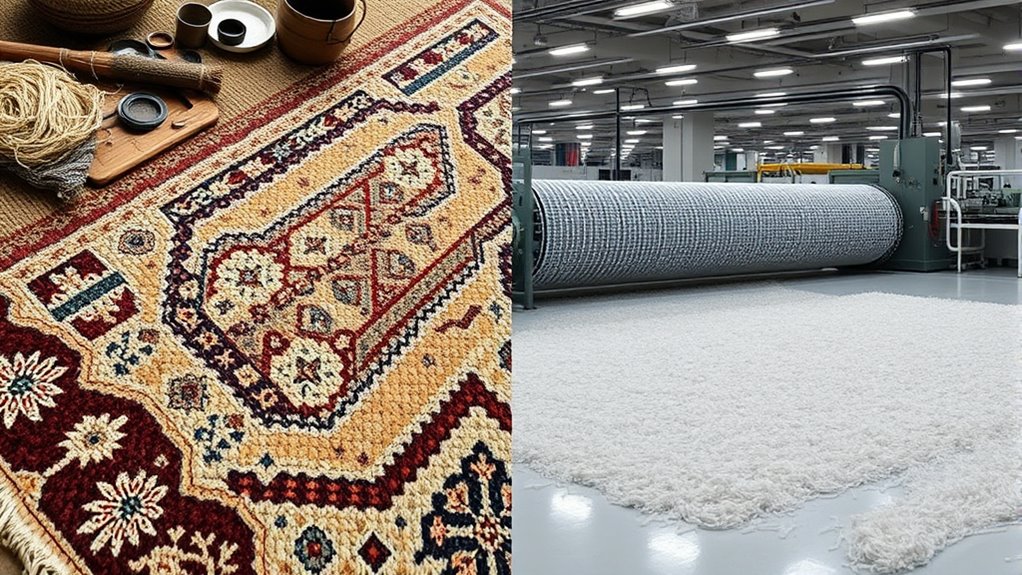
You should consider where rug materials come from and how their sourcing affects the environment. Sustainable harvest practices help reduce deforestation and habitat loss, making a big difference. Keep in mind that manufacturing emissions also play a role in the overall ecological impact of your rug choices, and choosing products made with efficient manufacturing practices can further minimize environmental harm. Additionally, selecting rugs made from eco-friendly materials supports sustainability throughout the production process, and understanding proper maintenance techniques can extend the lifespan of your rugs, reducing the need for frequent replacements. Implementing risk management strategies in the sourcing process can help identify and mitigate potential environmental and regulatory issues. Being aware of environmental impact assessments can also guide more sustainable sourcing decisions.
Raw Material Origins
Understanding where rug materials come from is essential to evaluating their environmental impact. The origins of fibers and dyes influence sustainability considerably. Natural fibers like wool and cotton often come from farms with varying ecological footprints, while synthetic fibers such as polyester and nylon are derived from fossil fuels, contributing to pollution. When sourcing materials, consider whether organic dyes are used, which reduce chemical runoff and water pollution. Visualize:
- Fields of organic cotton growing without pesticides or synthetic fertilizers
- Wool shearing from sheep raised on eco-friendly farms
- Factories producing synthetic fibers with high energy consumption and emissions
Each choice affects the rug’s overall carbon footprint, shaping its environmental friendliness. Knowing the raw material origins helps you make more sustainable decisions when selecting rugs.
Sustainable Harvest Practices
Adopting sustainable harvest practices is essential for minimizing the environmental impact of rug materials. By prioritizing a sustainable harvest, you guarantee that natural resources are replenished and ecosystems remain healthy. Eco-friendly cultivation methods, such as selective harvesting and responsible land management, reduce soil degradation and conserve biodiversity. These practices help prevent overharvesting, allowing plants like wool, jute, and other fibers to regenerate naturally. When you choose materials sourced through sustainable harvest methods, you support environmentally conscious production that reduces water use and minimizes chemical inputs. Implementing these practices makes your rugs more eco-friendly, aligning your choices with a commitment to sustainability. Incorporating body awareness techniques from somatic therapy can also foster a deeper understanding of how your environmental choices impact your overall well-being. This approach not only preserves the environment but also ensures the long-term availability of raw materials, as sustainable harvest methods promote resource renewal and ecosystem health. Additionally, adopting certified sustainable sourcing can further guarantee that your rug materials are obtained through environmentally responsible means. Recognizing the importance of environmental impact assessments helps ensure that harvesting practices support ecological balance and sustainability.
Manufacturing Emissions
Sustainable harvest practices help protect ecosystems, but the manufacturing stage also considerably impacts a rug’s overall carbon footprint. During production, choosing synthetic fibers can reduce resource use but often increases emissions, especially if they’re derived from fossil fuels. Machine-made rugs typically involve energy-intensive processes that emit more greenhouse gases, impacting the environment. Imagine a factory churning out hundreds of rugs daily, powered by electricity from non-renewable sources, creating a significant carbon footprint. The use of synthetic fibers can enhance the aesthetic appeal, offering vibrant colors and durability, but at a cost to sustainability. Environmental impact is further exacerbated by the reliance on fossil fuel-based energy sources. Factory fumes billow over landscapes, polluting air and water. Heavy machinery consumes vast amounts of energy daily. Synthetic fibers contribute to long-term environmental waste, and the manufacturing process often involves energy-intensive methods that increase overall emissions. Additionally, the lack of sustainable material sourcing practices can lead to depletion of natural resources and increased environmental degradation. Incorporating sustainable manufacturing practices not only reduces emissions but also promotes overall environmental responsibility, which is essential for long-term ecological balance.
Energy Consumption in Crafting Rugs
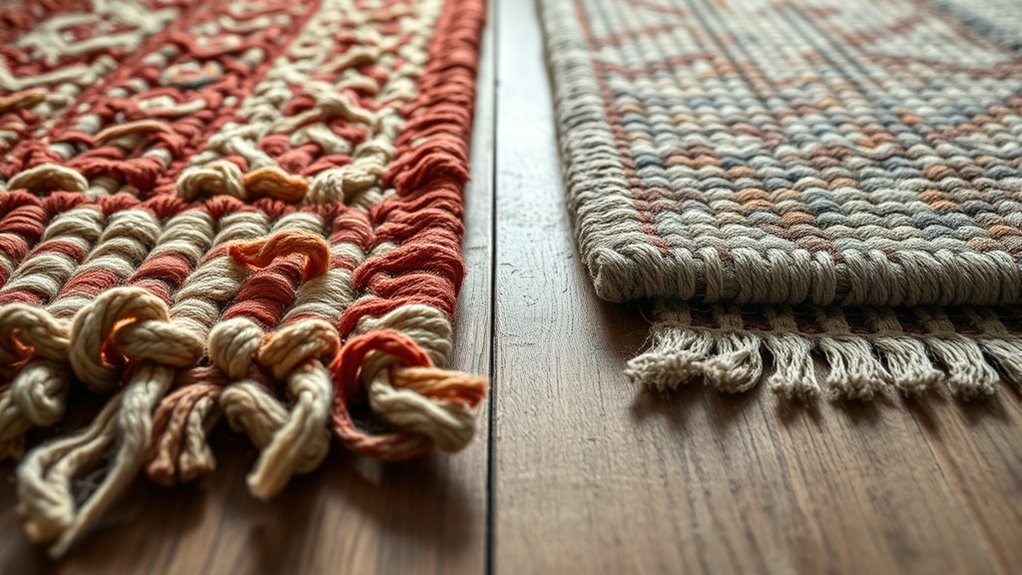
Crafting rugs consumes a significant amount of energy, especially during processes like spinning, weaving, dyeing, and finishing. When synthetic fibers are involved, the energy needed to produce and process these materials often increases, as manufacturing synthetic fibers requires substantial energy inputs. Hand-knotted rugs, rooted in artisan craftsmanship, typically involve less machinery and energy-intensive steps, relying more on skill and manual effort. Conversely, machine-made rugs often depend on automated processes that consume large amounts of electricity for spinning, weaving, and finishing. While artisans may use energy more efficiently, large-scale production with synthetic fibers can lead to higher overall energy consumption. Understanding these differences helps you evaluate the environmental impact associated with each rug type more accurately.
Water Usage and Waste Management
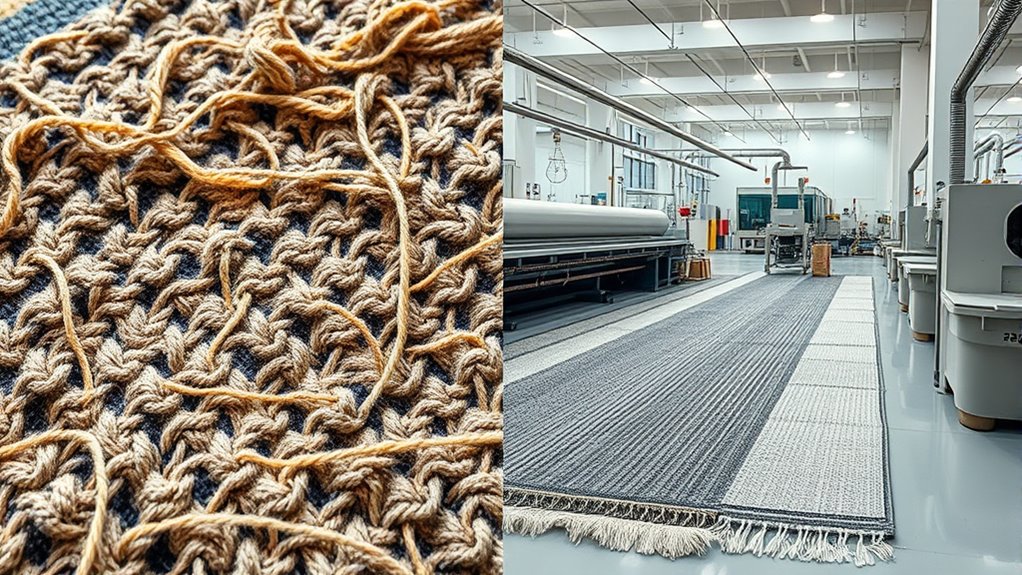
Water plays a crucial role in rug production, especially during dyeing, washing, and finishing processes. To minimize environmental impact, you should focus on water conservation by implementing efficient dyeing techniques and recycling water whenever possible. Waste management involves reducing chemical and textile waste through careful planning and recycling scraps. Picture:
- Water-saving equipment used during dyeing to cut down consumption
- Chemical waste safely stored and disposed of to prevent pollution
- Reusing leftover dye baths to minimize waste and conserve resources
Durability and Lifespan of Different Rugs

When choosing a rug, consider how well it withstands wear and tear over time. You’ll want one that’s easy to repair and maintain, prolonging its usability. Understanding material resilience helps you pick options that stay durable and eco-friendly longer.
Material Resilience Over Time
The durability and lifespan of rugs markedly influence their environmental impact over time. When considering material resilience, think about how well a rug maintains its appearance and quality. Hand-knotted rugs often excel in durability, but may face colorfastness issues, especially with natural dyes that fade unevenly. Machine-made rugs, while consistent in color and pattern, might wear faster under heavy use. Visualize a rug that retains vibrant hues after years of foot traffic or one that shows signs of aesthetic variability, such as fading or fraying. These factors directly affect how long you can enjoy your rug before replacing it, impacting its overall carbon footprint. Choosing resilient materials ensures your rug lasts longer, reducing waste and the need for frequent replacements.
Repair and Maintenance Ease
Material resilience plays a significant role in how easily a rug can be repaired and maintained over its lifespan. Hand-knotted rugs often have higher repair difficulty due to intricate craftsmanship, which can increase maintenance costs. Conversely, machine-made rugs tend to be more straightforward to repair, reducing both repair time and expenses. When damage occurs, you’ll find that resilient materials help preserve the rug’s integrity longer, making repairs less frequent and less costly. Durability also influences the ease of maintenance; a sturdy rug resists stains and wear better, saving you effort and money over time. Overall, choosing a rug with good material resilience means fewer repairs, lower maintenance costs, and a longer-lasting piece that stays beautiful for years.
Wear and Tear Resistance
Choosing a rug with strong wear and tear resistance guarantees it remains durable and maintains its appearance over time. High weave strength and fiber durability are key factors that determine how well a rug withstands daily foot traffic and friction. Hand-knotted rugs often feature tight weaves and robust fibers, making them highly resilient. In contrast, machine-made rugs can vary in durability depending on manufacturing quality. Visualize a rug that resists crushing, fading, and fraying, even after years of use. Imagine walking barefoot on a rug that stays plush, or children playing without causing damage.
- Tight, dense knots that resist crushing
- Hard-wearing fibers like wool or nylon
- Strong, consistent weave patterns that prevent unraveling
Transportation and Distribution Footprint
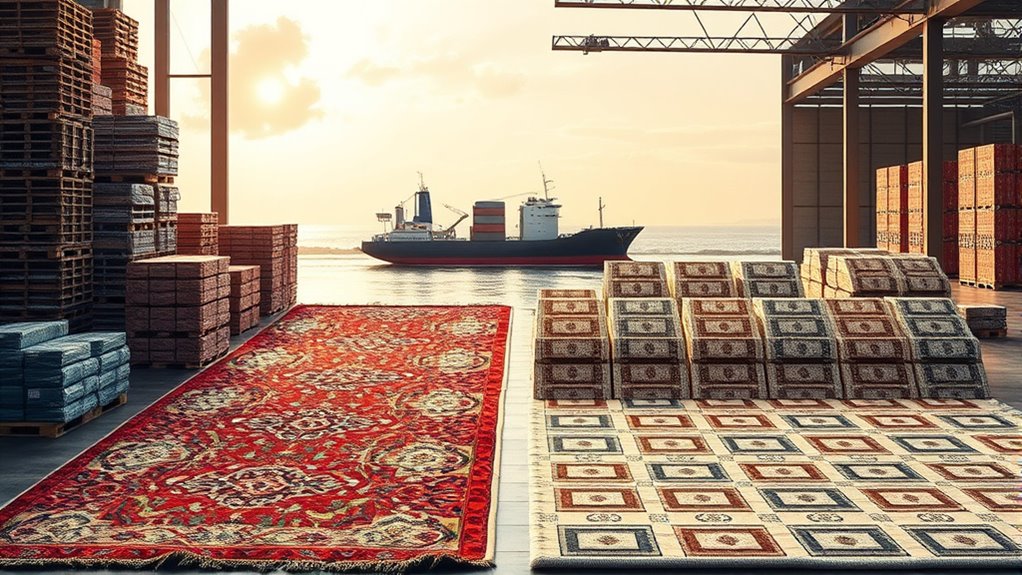
Transportation and distribution substantially contribute to a rug’s overall carbon footprint, as moving products from factories to consumers involves considerable energy use. Shipping costs are a major factor, often reflecting the fuel and resources needed to transport the rug across long distances. The type of packaging materials used also impacts environmental impact; bulky or non-recyclable packaging increases waste and energy consumption. Hand-knotted rugs, which are often produced locally, typically have a smaller transportation footprint than machine-made rugs that may be mass-produced overseas and shipped globally. Choosing local artisans or retailers can reduce shipping distances and related emissions. Additionally, opting for minimal, eco-friendly packaging helps lower the overall carbon footprint of distribution, making your rug purchase more sustainable.
End-of-Life and Recycling Potential

When a rug reaches the end of its life, your options for disposal can considerably impact the environment. Choosing recycling initiatives over landfilling reduces landfill impact and supports sustainability. Hand-knotted rugs often contain natural materials that can be repurposed or composted, while machine-made rugs may include synthetic fibers that are harder to recycle.
Imagine:
- The fibers breaking down naturally, returning nutrients to the soil
- Rugs being transformed into new products through recycling programs
- Waste filling up landfills, contributing to pollution and resource depletion
Comparing Carbon Emissions Over the Lifecycle
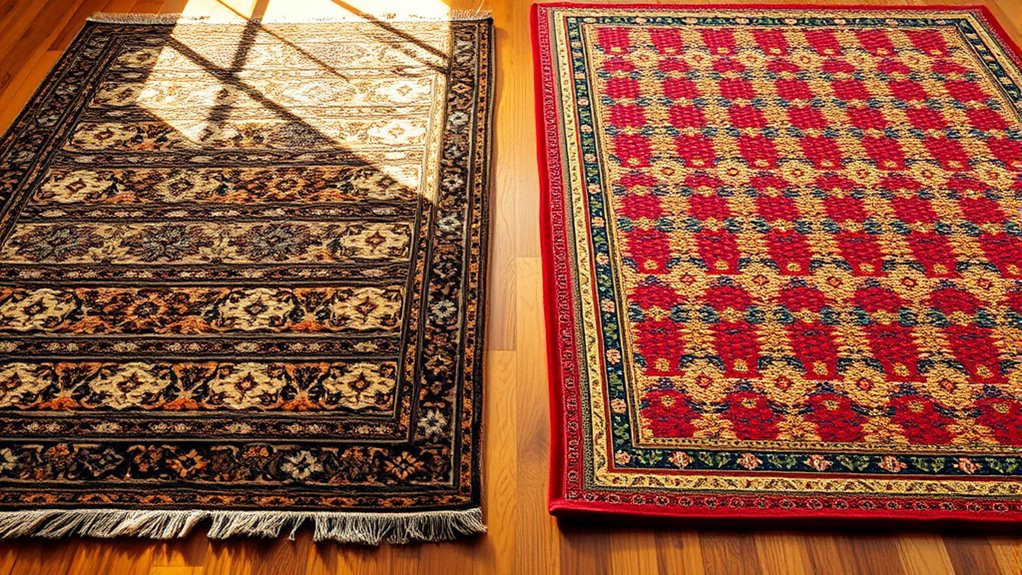
To understand the environmental impact of rugs, it is vital to compare their carbon emissions throughout their entire lifecycle. Hand-knotted rugs often carry cultural significance and showcase artistic craftsmanship, which extends their production time and energy use. This detailed process means higher emissions initially but can result in longer-lasting, durable pieces that reduce replacement frequency. Conversely, machine-made rugs are produced more quickly and with less energy upfront, but their shorter lifespan may lead to more frequent replacements, increasing overall emissions. When comparing the full lifecycle, consider not just the manufacturing phase but also the durability, maintenance, and disposal. This all-encompassing view helps you make more informed choices aligned with reducing your overall carbon footprint.
Making Sustainable Choices for Your Home
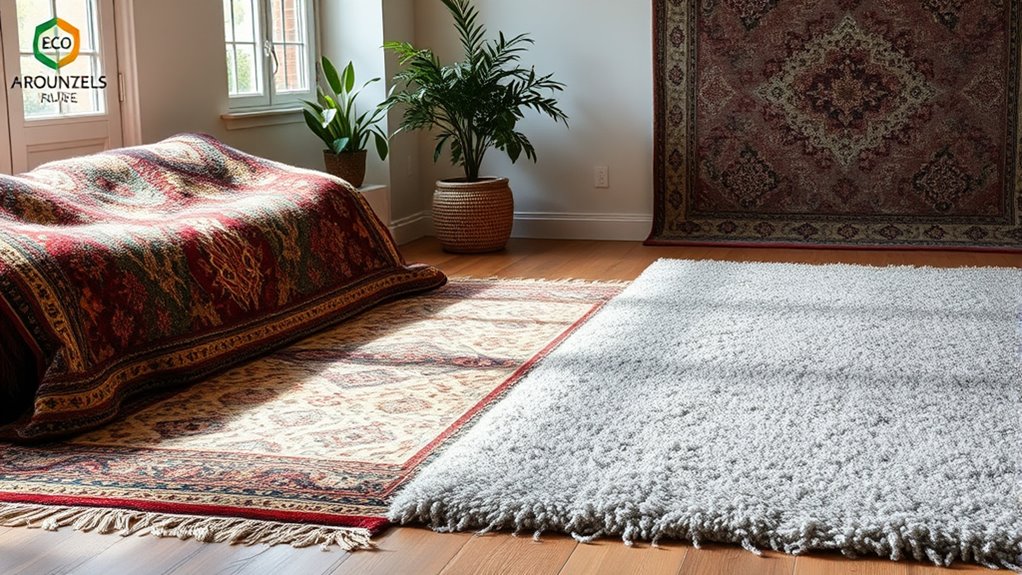
Making sustainable choices for your home starts with being mindful of the materials and products you select, especially for items like rugs that impact your environment over their entire lifecycle. Opt for rugs made with eco friendly dyes, which reduce chemical pollution and lessen environmental harm. Prioritize brands that support ethical labor, ensuring artisans are paid fairly and work in safe conditions. Visualize a handmade rug dyed with natural pigments, produced by artisans who take pride in their craft, rather than mass-produced options that rely on synthetic chemicals and exploit workers.
Choose eco-friendly dyes and fair labor practices for a sustainable, beautifully crafted rug you can feel good about.
- Imagine vibrant, natural hues blending seamlessly into your decor
- Picture artisans carefully applying eco friendly dyes with skill and care
- Envision supporting fair wages and sustainable practices with each purchase
Frequently Asked Questions
How Do the Dyes Used in Rugs Affect Their Overall Environmental Impact?
You might wonder how dyes impact a rug’s environmental footprint. Natural dyes, derived from plants and minerals, generally produce fewer synthetic emissions and are more eco-friendly. In contrast, synthetic dyes often release harmful chemicals and increase the overall environmental impact. By choosing rugs dyed with natural dyes, you help reduce pollution and support sustainable practices, making your decor both beautiful and environmentally conscious.
What Certifications Indicate a Rug’s Eco-Friendly Manufacturing Practices?
When looking for eco-friendly rugs, certifications like GOTS (Global Organic Textile Standard), OEKO-TEX, and Fair Trade show you’re choosing products made with natural fibers from renewable resources. These certifications guarantee the manufacturing process minimizes environmental impact, uses non-toxic dyes, and supports fair labor practices. By choosing rugs with these labels, you actively support sustainable practices, reducing your environmental footprint and promoting healthier environments for everyone.
Can Rug Cleaning Methods Influence Their Carbon Footprint?
You can definitely influence a rug’s carbon footprint through your cleaning choices. Opt for eco-friendly cleaning methods that use biodegradable solutions, which reduce environmental impact. Avoid harsh chemicals, and consider professional cleaning services that prioritize sustainability. These eco-friendly approaches minimize emissions and waste, helping lower your rug’s overall carbon footprint. By choosing biodegradable solutions, you contribute to a healthier planet while keeping your rug clean and fresh.
How Do Local Versus Imported Rugs Compare Environmentally?
When comparing local versus imported rugs, you should consider the environmental impact of local sourcing, which typically involves less transportation and reduces carbon emissions. Imported rugs often have a higher footprint due to import transportation, which increases greenhouse gases. By choosing local rugs, you help lower overall emissions, supporting a more eco-friendly approach. So, opt for local sourcing whenever possible to minimize your rug’s environmental footprint.
What Innovations Are Emerging to Make Rug Production More Sustainable?
You’re exploring innovations that make rug production more sustainable. New methods focus on using natural fibers and renewable materials, reducing environmental impact. For instance, some manufacturers adopt eco-friendly dyes and energy-efficient machinery, while others develop biodegradable or recycled backing materials. These advancements help lower carbon footprints, promote responsible sourcing, and support eco-conscious consumers like you who want stylish rugs that also protect the planet.
Conclusion
Choosing between hand-knotted and machine-made rugs is like picking between a handcrafted masterpiece and a factory-produced replica—both have their place, but one leaves a lighter footprint. By understanding the environmental impacts, you can make smarter, greener choices for your home. Remember, every rug tells a story—opt for the one that not only beautifies your space but also preserves our planet’s beauty for generations to come. Your conscious choice can turn your home into a sanctuary for sustainability.
